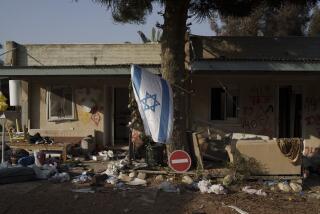Cloak and stagger
Last month’s unclassified congressional briefing on Syria’s clandestine nuclear reactor, which was destroyed by Israel on Sept. 6, 2007, was yet another reminder of the challenges confronting the U.S. intelligence community. Still smarting from its gross overestimation of Iraq’s weapons of mass destruction, the community bent over backward to avoid overstating its case against Syria -- and in doing so, it stumbled badly.
In the Syrian case (as with the release last year of part of the National Intelligence Estimate on Iran’s nuclear program) the intelligence community was unnecessarily cautious, and thereby underestimated the threats posed by Syria and Iran. Its efforts to improve precision have only created new confusion and uncertainty.
The key problem has been the intelligence community’s astonishing awkwardness in making clear what’s a fact and what’s an inference. In the case of Iraq, there were few facts on which to build a convincing case that Saddam Hussein was arming himself with weapons of mass destruction. But Hussein’s past pursuit of them, coupled with the anxieties unleashed by 9/11, led U.S. intelligence analysts and many policymakers to infer the worst and leap to conclusions unsupported by the facts.
The intelligence community has now jumped to the opposite extreme with respect to Iran’s and Syria’s nuclear ambitions, where there are more than a few facts. Yet it has virtually refused to draw any conclusions, no matter how obvious, about the two countries’ nuclear programs. The effect has been to seriously understate the dangers Iran and Syria pose and to distort the policy options available to the U.S. to manage them.
When the unclassified summary of the NIE on Iran’s nuclear program was released Dec. 3, many observers were shocked by its most prominent “key finding” -- that the intelligence community believed with “high confidence” that Iran had halted its “nuclear weapon program” in late 2003. A footnote defined “nuclear weapon program” as Iran’s efforts to design a nuclear weapon and to enrich uranium in secret. That definition is extremely narrow because most proliferation experts view designing the bomb as relatively easy compared with producing the necessary fissile materials for its core and developing a delivery system.
As a result, the summary paid scant attention to those two nuclear-weapon-related -- and extremely dangerous -- activities in Iran. In fact, the summary doesn’t even mention the missiles, and Iran’s uranium enrichment activities, the focal point of U.S. and U.N. Security Council diplomacy and pressure, are described in the blandest of terms.
Why? Based on comments at a recent roundtable of U.S. officials and outside proliferation experts that we co-chaired, those responsible for the NIE on Iran knew that the heads of the 16 U.S. intelligence agencies had agreed that its key findings would not be declassified. But the White House, fearful that the findings might leak to the media without any official explanation of their significance, overruled the agencies.
By the time the White House decided to release an unclassified summary, the classified version had been produced and was about to be handed over to the congressional intelligence committees. That created a problem. Even though the estimate’s “key findings” were originally intended to be understood in the context of the whole classified report, the intelligence community and the White House felt that they needed to repeat them almost verbatim in the unclassified summary. They worried that any rephrasing of the findings would open them up to accusations of playing politics with the estimate.
That still leaves the question of why the intelligence community spotlighted the finding on Iran’s nuclear weapons program. We know that important new evidence on Iran’s nuclear activities in 2003 had been obtained and that it had required changing a 2005 estimate that the country was pursuing a nuclear weapon. In highlighting the new data, the authors of the 2007 unclassified summary unfortunately left out the context of the previous estimate -- that a rogue Iran remained well on course to developing a nuclear capability.
Ever since Dec. 3, the intelligence community has been trying to restore context to its key finding. On Feb. 27, Director of National Intelligence Michael McConnell said the release of the unclassified version was rushed and that it was “an error of judgment on my part.” Days later, Defense Intelligence Agency Director Lt. Gen. Michael D. Maples said that “although Iran claims its program is focused on producing commercial electric power, [we assess] with high confidence Iran remains determined to develop nuclear weapons.” Then in March, CIA chief Michael Hayden, asked on NBC’s “Meet the Press” whether he thought Iran was trying to develop a nuclear weapon, replied “Yes,” adding this was not based on “court-of-law stuff. ... This is Mike Hayden looking at the body of evidence.”
These statements were a move in the right direction, but the CIA’s linguistic fumbling during last month’s congressional briefing on Syria’s reactor indicates that the snafu over the Iran estimate is not a one-time blunder.
--
After going to considerable lengths to show that Syria’s reactor was built with North Korea’s help, that it was modeled on the reactor that the North Koreans used to produce plutonium for their nuclear weapons and that it had been carefully disguised by the Syrians to avoid detection, senior intelligence officials declared they had only “low confidence” that Syria has a nuclear weapons program.
The justification for this bizarre conclusion? Although it has “a rich level of information” about the destroyed reactor and North Korea’s involvement in building it, the intelligence community said it has no specific information on Syrian facilities for the manufacture of fuel for the reactor or for processing the fuel after it is irradiated to extract plutonium. Nor has it any information showing that Syria is working on a design for a nuclear warhead.
While well-intentioned, the intelligence community’s efforts at clarity have now twice gone astray. If it wants to right the balance between facts and inference, a starting point might be to stop redefining commonly used phrases -- such as “nuclear weapon program” -- in order to give them new, counterintuitive meanings that obscure a more simple and dangerous reality.
When the intelligence community has real evidence, it should not be afraid to draw the obvious inference and call a spade a spade.
More to Read
Sign up for Essential California
The most important California stories and recommendations in your inbox every morning.
You may occasionally receive promotional content from the Los Angeles Times.










